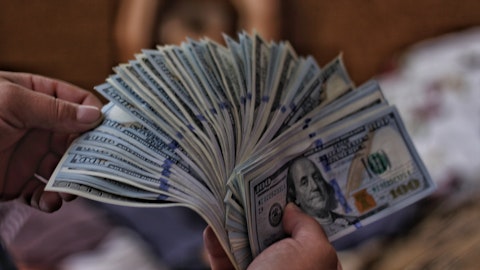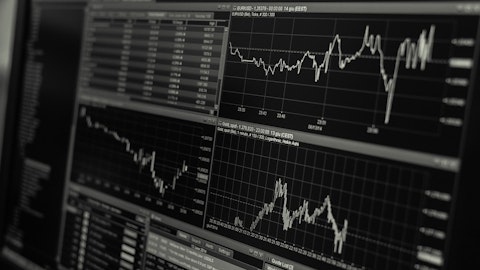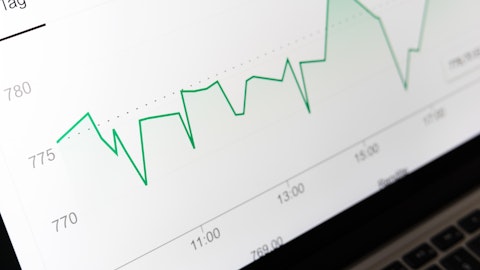And so that’s a tough place to be to have that pressure to put money to work. I think there’s so much capital being raised because we’re in this Nirvana situation where for this asset class, it’s the first time historically in years where you’ve had both an increase in base rates and spreads and as we’ve talked about in the past, you’re generating all-in yields in the low double-digits. I will say that just given the competitive nature and the number of platforms, it is getting competitive, especially for good quality deals. You can’t really compete on leverage, just given where rates are. So we’re really seeing deals being moderately levered around, call it, 4.5 times senior. Docs are still in our favor as lenders. But as you kind of raise, we are seeing some compression in spreads in the last quarter of last year.
I’d say, spread — or the last half of last year, I’d say spreads compressed about 50 to 75 basis points, upfront is about 50 basis points, but all in all, you’re still generating upper single-digit yields. I think as the market opens up and more attractive opportunities are out there, I think that competitive nature will continue. I mean — it’s again, historically, this asset class generates senior debt, 6% to 8%. We’re over that right now. So I think you have to expect over time as the market becomes more normalized, you’re going to have some reversion of all-in yields back to sort of the historical returns that we’ve had in the asset class.
Kyle Joseph: Got it. Helpful. And then one follow-up just on repayments. Obviously, they were elevated in the fourth quarter, but it sounds like some of that was self-induced for lack of a better term than you guys are rotating out of Sierra and NBC. But if we do get this pickup in deal flow, would you expect a corresponding increase in repayments as well? Or how does the higher rate environment influence that?
Matt Freund: Yeah. Kyle, this is Matt. I would certainly agree with the sentiment that if we see kind of an increase in deployment opportunity, that’s necessarily going to be a corollary to increased exit opportunities on the other side. I think that if we look at the portfolio, average hold horizon is kind of stretched up to, call it, four-ish years, plus or minus. And while we feel really good about the quality of the credit in the portfolio, eventually, we’re going to see some turnover. So it’s not something that concerns us in any capacity, but I think it will start to return to kind of a historical means. Does that answer your question?
Kyle Joseph: Yeah, yep. Thanks guys. Appreciate it.
Matt Freund: Of course.
Operator: Thank you. The next question is coming from Robert Dodd of Raymond James. Please go ahead.
Robert Dodd: Hi guys. On the Core Scientific. You mentioned — by my math, you probably got a little over 6 million shares now on that after the exchange. I mean, is it the same price of stock that’s publicly traded? And what’s the intent there? I mean are you intending to hold that? Are you locked up or you’re looking to liquidate the shares you’ve got from that position and maybe rotate them into something income producing?
Bryan High: Yeah. Hey, Robert, this is Bryan. So in terms of the stock itself, it is the same stock that you would see on the public markets. Our intent there is to maximize recoveries, but also I think we’ve been pretty clear that, that’s not part of our ongoing strategy. So marrying those two things together over the course of the coming quarters is sort of on us to make decisions around what to do with that. Obviously, having a public stock gives us some liquidity, and that was the intent in making that election within the bankruptcy proceeding.
Robert Dodd: Got it. Thank you. And because it ties in, I mean your 15% equity, some of that obviously is income producing located, et cetera. But obviously, this, as of today, pro forma for this equity is going to be 16% plus. I think if my math is right. Can you give us a recap back what’s a reasonable timeline to get at least the non-income producing piece of equity down into the — into maybe the mid-single-digit?
Bryan High: So it’s a great question. And so as we’ve tried to articulate in past quarters, we have described our investment philosophy and kind of the buckets around strategy. And as it sits as of 12/31, we kind of have 8% of the portfolio that sits in other. The big kind of noteworthy items in that other bucket today would include two large European equity positions. The position in Core Scientific that was previously a debt security and will now be an equity position, as you know and then a handful of other candidly, non-core, non-future style strategies. As we think about where that 8% goes over — and so I think organizationally, we’re really focused on the 8%, not necessarily just on the equity piece of it, but on the 8% of the other.
And the important distinction is that Rocade and Eclipse, both constitute equity, but we expect those will be part of our go-forward strategy kind of in the perpetuity. And so as we kind of roll forward four quarters in the future, our hope would be that we could cut that number, that 8% non-core to something closer to 4% to 5% by the time we get to the end of the year, the biggest movers in that are going to be one of the two large European equity positions we’re hoping to monetize and then Core Scientific public equity, which we are hoping to monetize, of course, only at levels that we find to be reasonable returns of capital. And so I would guide you to that benchmark as we look forward to the next handful of quarters.
Eric Lloyd: And as a reminder, those two large European equity positions that don’t have yield were acquired. Those aren’t things that we made an underwritten investment on. Unlike Rocade or Eclipse, which have attractive yields that come off them.





